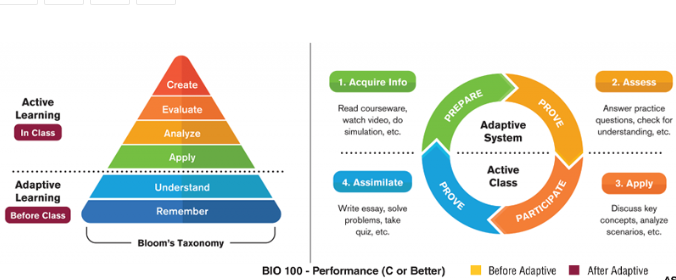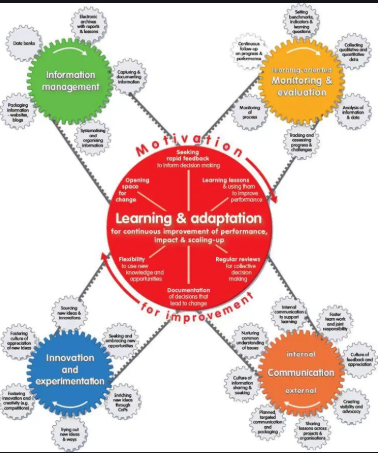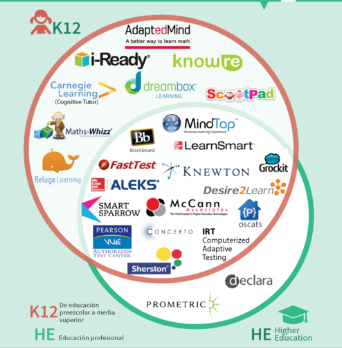e-Learning Ecologies MOOC’s Updates
ADAPTIVE LEARNING
e-Learning Ecologies: Innovative Approaches to Teaching and Learning for the Digital Age
COURSERA:
Universidad de Illinois en Urbana-Champaign
ADAPTIVE LEARNING:
By: Shendel Badillo-Avilés
What is it?
Adaptive learning is an educational method that, thanks to the modification of the contents in real time, adapts to the rhythm and knowledge of the students. For this it is based on the use of ICT, Artificial Intelligence and data analysis, also known as ‘Learning analytics’. All this allows to collect and analyze information related to the learning of each student, evaluating their needs. The goal is for teachers to provide more personalized attention in the classroom.
Although this type of learning has gained popularity in recent years, the truth is that its development dates back to the 1970s, when the first steps of Artificial Intelligence emerged.
This theory focuses on directing human learning through a series of actions controlled through four principles: the setting of objectives, the division of content, the inclusion of increasing difficulty in learning and actively participating in the student body. This psychologist was also in charge of creating a teaching machine called Glider that allowed to automatically control the entire learning process of students through linear progression.
There are different learning management systems (LMS) software that, with platforms such as Moodle, have popularized ‘learning at your own pace’ in the training sector.
IMAGE FROM : ARIZONA STATE UNIVERSITY: https://iblnews.es/asu-transforma-la-educacion-cientifica-de-pregrado-desarrollando-el-primer-grado-de-aprendizaje-adaptativo/
Opportunities in the classroom
In the educational field, adaptive learning opens the doors to teaching based on the rhythm of each student, making them aware at all times of their academic achievements, but also of what they need to reinforce.
Through self-learning, this type of teaching provides the following opportunities in the classroom:
• Students are protagonists of their own learning.
• Feedback of errors in real time.
• Assessment is adaptive based on results.
• It offers greater autonomy for the students in carrying out the tasks.
• It allows an effective acquisition of knowledge and the development of the abilities of each student.
• Increase motivation.
• Save time on teacher assignments.
Application
Below we show different tools differentiated by educational level to enjoy the benefits of adaptive learning in the classroom.
Adaptive learning in Infant and Primary
At these educational levels, where new knowledge is being learned in all subjects, adaptive learning platforms related to reading or math skills are very useful.
LightSail encourages reading to engage students in reading practice. The objective is that, little by little, they read for a longer time thanks to a library of books adapted to the preferences and needs of each student. By means of a classification method, the motivation of the students is increased, who spends a few more minutes each day reading.
i-Ready is based on individualized learning in Mathematics and reading. It is divided into lessons and has different animated characters that encourage the student to achieve their goals.
IMAGE FROM:
https://juandomingofarnos.wordpress.com/2018/01/11/aprendizaje-adaptativo-y-personalizado/
Adaptive learning in Secondary and Baccalaureate
In these higher courses, where you have to pay attention to other issues such as concentration, memory or motivation to study, these platforms help to consolidate the content using gamification or through challenges.
Carnegie Learning's Mathia software, which offers an individual and personalized ‘trainer’ for the Mathematics subject, makes use of gamification and artificial intelligence, being one of the alternatives for these courses.
Also, the Smartbook platform, by McGrawHill, analyzes the way of reading and learning of Secondary and Baccalaureate students adapting the contents of their interactive book in a personalized way.
Finally, Knewton personalizes learning based on the interactions of the students registered on the platform, which creates a kind of curriculum for each student who changes according to their progress. The teaching material comes from the content offered by various publishers (associated with the platform), which facilitates their inclusion in the classroom.
IMAGE FROM: ITESM https://www.pinterest.de/pin/532550724670790145/
References:
Brusilovsky, P. (2001). Adaptive hypermedia. User Modeling and User-Adapted Interaction, 11, 87–110.
Google Scholar
De Bra, P. M. E. (2008). Adaptive hypermedia. In H. H. Adelsberger, J. M. Pawlowski, P. Kinshuk, & D. Sampson (Eds.), Handbook of information technologies for education and training (2nd ed., pp. 29–46). Heidelberg: Springer.
Google Scholar
De Bra, P. M. E., Pechenizkiy, M., van der Sluijs, K., & Smits, D. (2008). GRAPPLE: Integrating adaptive learning into learning management systems. In Proceedings of World Conference on Educational Multimedia, Hypermedia and Telecommunications 2008 (pp. 5183–5188). Chesapeake, VA: AACE.
Google Scholar
Koedinger, K. R., & Corbett, A. T. (2006). Cognitive tutors: Technology bringing learning sciences to the classroom. In R. K. Sawyer (Ed.), The cambridge handbook of the learning sciences (pp. 61–77). New York: Cambridge University Press.
Google Scholar
Paramythis, A., & Loidl-Reisinger, S. (2004). Adaptive learning environments and e-learning standards. Electric Journal of e-Learning, 2(1), 181–194.
Google Scholar
Weber, G., & Brusilovsky, P. (2001). ELM-ART: An adaptive versatile system for web-based instruction. International Journal of Artificial Intelligence in Education, 12(4), 351–384.
Google Scholar




